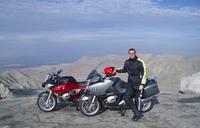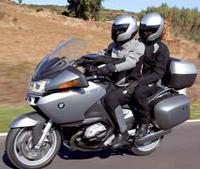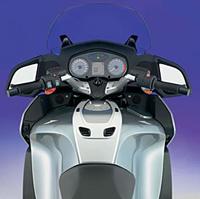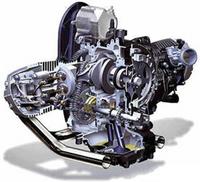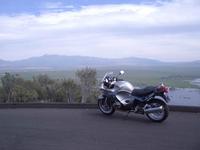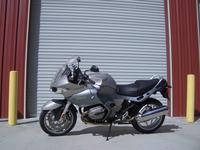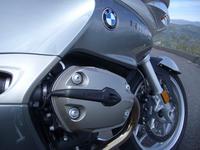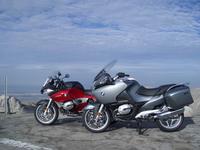BMW 1200 ST and 1200 RT Reviews
Nicholas Frankl Contributing Editor
If you’re going to test new motorbikes, you may as well head for the deserts of Palm Springs and surrounding mountains, the California riding nirvana equivalent of the Scottish highlands, but with a little less (but still surprisingly prevalent) fauna. BMW brought 50 odd models of the new 1200 ST and RT, plus a smattering of others from the range, to whet the assorted journalists’ whiskers, such as the 1200 S and R – a stripped down, naked version of the S which is by far the most radical street bike BMW has ever offered.
The ST and RT are vastly improved over the previous 1150 models they replace. BMW refers to them as 100% new, which theoretically is true, however they both share many of the best components from the GS including the new 1170cc four-value-per-cylinder Boxer twin and few bits from the outgoing 1150’s. The new engine produces 110bhp, 15 hp more than the outgoing model’s motor, 10 hp more than the current GS and this, combined with a weight saving of 70 pounds on the RT and 55 pounds on the RS, equals significantly enhanced performance and handling characteristics.
I started the day with the RT – wisely I thought, as the ST was sure to be a dynamically more nimble and faster bike and I didn’t want to prejudice my appraisal. The RT is certainly dramatically different in styling then anything that’s gone before. Designed in the wind tunnel with integrated and large rearview / turn signal mirrors, a larger windscreen that is both taller and wider creates a large ‘rider window’ for better protection from the elements. The layout of the controls and riding position will be familiar to any RT owner. Though the controls have been updated, the handlebar is a carryover and filled with buttons for heating the grips and seat, the optional ESA ($750), volume controls for the radio, cruise control, indicators and emergency flashers. Onboard the riding position is upright and comfortable with various seating positions available - BMW has made efforts to accommodate everyone. The electrically-adjustable screen works very well, especially in the raised position. The radio and speakers are excellent and the volume is automatically speed adjustable. Vibrations from the engine have been significantly reduced with the employment of a counterbalancing shaft to eliminate ‘rocking couple’ – a term I would previously have associated with Pamela Anderson and Tommy Lee. Of course vibrations are all relative, and the fact remains that both the ST and RT leave their mark on your endoskeleton as your hands communicate the unique sensations of the boxer through your body.
Climbing high above the flat plains of Palm Springs and into the mountains you are struck by how light on its feet the RT feels, flowing nicely into sharp 2nd and 3rd gear bends and allowing the rider to explore the upper ranges of the throbbing twin, which now redlines at 8,000 revs, in relaxed comfort and total control. The all-new transmission, shared with the GS and using helical-cut gears, is smooth and precise and doesn’t require any maintenance for 25,000 miles. With the new forged-aluminum Evo-Paralever shaft final drive and an updated Telelever arrangement upfront, the handling is right up there with the Honda ST1300 sports tourer and Yamaha FJR1300 too. As we climbed above 4,000 feet, the temperature dropped and I was very happy to have the heated grips and seat, which do work extremely well and provide the rider with the ability to ride longer and further in comfort without having to stop and refresh or warm-up. After 50 miles or so I was really beginning to enjoy the RT, the promise had been delivered and it got better when I managed to catch up with the ST rider group and compare the performance of the bikes directly. Bottom line was that in and out of slow and fast corners the STs weren’t able to pull away at all – in fact it was difficult to tell that we weren’t all on identical bikes.
After lunch it was ST time. The ST is a bold if not necessarily particularly beautiful bike. I think purposeful is probably a suitable descriptive. Immediately you can feel that the bike is lighter. This is reflected not just in the general feel of the bike but the inputs required to command it, too. The engine seems to rev more keenly and you do accelerate noticeably quicker. In corners the ST is fast and fluid, although it doesn’t surprise in the same way as the RT, as you expect it to perform at a higher level. It may have been the good lunch, the warmer afternoon temperature or just the familiarity of the roads but I certainly rode the ST faster and more aggressively than the RT in the morning. The riding position is more aggressive and angled, the controls very similar to the RT. Missing, or rather lacking, is the formidable RT windscreen. It’s funny that you only miss something when you don’t have it and that goes for the EVO ABS system that is an option on the ST as well. However, although I preferred the ST for personal transport, I wasn’t as impressed with it as I was the RT. Essentially, I wouldn’t buy one. There are simply too many other bikes on the market that cost the same or less and do a better sports tourer job: The brilliant Honda V-4 interceptor for one. The RT, on the other hand, is a great piece of motorcycling engineering. You can find faults with any manufacturer but you cannot fault the exacting quality of BMW motorcycles and that goes for their range of clothing too which I was wearing during the launch. The clothing allows for non-converts to enjoy the same standards of excellence , research and development but without the expense of purchasing a BMW bike! The Kevlar-lined denim suit is a great daily outfit and I’m excited to try out the reflect leather at some point as it reduces body heat significantly – a good attribute during hot California summers.
Overall both the ST and RT will please existing 1150 model owners. They do the same jobs, just better, more efficiently and more comfortably. The RT has a good stab at bringing new touring owners into the Bavarian stable but the bike isn’t cheap. MSRP for the R 1200 RT is $17,490 without ESA as standard equipment, but you get what you pay for in this market. No doubt the Yamaha is faster, but that doesn’t make it necessarily better overall. The ST is a half way house. It isn’t dynamically different enough to make up for the lack of touring abilities afforded by the RT, and it isn’t exciting enough to grab riders off the competition. As you will have read from the GS review, I’m not a boxer fan, the same as I’m not a stock Harley fan either. I prefer my fingers without tingling sensations. That said, I respect and appreciate both. I also expect to find salvation in the 1200 S and R when they break daylight in a couple of months.
R 1200 ST
MSRP $14,990
Engine
Type Air/oil-cooled 2-cylinder 4-stroke Boxer engine, one camshaft and four valves per cylinder, central compensation shaft
Bore / stroke 101 mm x 73 mm
Capacity 1,170 ccm
Rated output 81 kW (110 bhp) at 7500 rpm
Max. torque 115 Nm at 6000 rpm
Compression ratio 12.0:1
Mixture control / engine management Electronic intake pipe injection/digital engine management: BMW engine management, BMS-K with overrun fuel cut-off, dual ignition
Emission control Closed-loop 3-way catalytic converter
Performance / fuel consumption
Maximum speed More than 200 km/h
Fuel consumption over 100 km at constant 90 km/h 3,7 l
Fuel consumption over 100 km at constant 120 km/h 5.1 l
Fuel type Unleaded premium, minimum octane rating 98 (ROZ), can also be operated with minimum octane number 95 (RON) due to automatic knock control.
Electrical system
Alternator 720 W three-phase alternator
Battery 12 V / 14 Ah
Power transmission
Clutch Single-disc dry clutch, hydraulically operated
Gearbox Constant mesh 6-speed gearbox with helical gearing
Drive Shaft drive
Chassis / brakes
Frame Three-section frame consisting of front and rear section, load bearing engine-gearbox unit
Front wheel location / suspension BMW Motorrad Telelever; stanchion diameter 41 mm, central spring strut
Rear wheel location / suspension Die-cast aluminium single-sided swinging arm with BMW Motorrad Paralever, WAD suspension element; spring pre-load hydraulically adjustable to continuously variable levels by means of handwheel, rebound damping adjustable
Travel front/rear 110 mm / 140 mm
Wheelbase (in normal position) 1,502 mm
Castor (in normal position) 112 mm
Steering head angle (in normal position) 63°
Wheels Die-cast aluminium wheels
Rim front 3.50 x 17
Rim rear 5.50 x 17
Tyres front 120/70 ZR 17
Tyres rear 180/55 ZR 17
Brake front EVO brake system with dual disc, floating brake discs, 320 mm diameter, four-piston fixed caliper
Brake rear Single disc brake, diameter 265 mm, double-piston floating caliper
ABS Special equipment BMW Motorrad Integral ABS (part-integral)
Dimensions / Weight
Length 2,165 mm
Width (inc. mirrors) 890 mm
Height (not inc. mirrors) 1,220 mm
Seat height, unladen weight 826 / 806 mm (Special equipment low seat bench 780/800 mm)
Unladen weight, road ready, fully fuelled 1) 229 kg
Dry weight 2) 205 kg
Permitted total weight 460 kg
Payload (with standard equipment) 231 kg
Usable tank volume 21.0 l
Reserve Approx. 4.0 l
1) According to guideline 93/93/EWG with all fluids, fuelled with at least 90% of usable tank volume 2) Unladen weight without fluids
Technical data Travel and trainings Test reports Your contact
R 1200 RT
MSRP $17,490
Engine
Type Air/oil-cooled 2-cylinder 4-stroke Boxer engine, one camshaft and four valves per cylinder, central compensation shaft
Bore / stroke 101 mm x 73 mm
Capacity 1,170 ccm
Rated output 81 kW (110 bhp) at 7500 rpm
Max. torque 115 Nm at 6000 rpm
Compression ratio 12.0:1
Mixture control / engine management Electronic intake pipe injection/digital engine management: BMW engine management, BMS-K with overrun fuel cut-off, dual ignition
Emission control Closed-loop 3-way catalytic converter
Performance / fuel consumption
Maximum speed More than 200 km/h
Fuel consumption over 100 km at constant 90 km/h 3.6 l
Fuel consumption over 100 km at constant 120 km/h 4.8 l
Fuel type Unleaded premium, octane rumber 98 (RON), can also be operated with minimum octane number 95 (RON) due to automatic knock control.
Electrical system
Alternator 720 W / 60 A three-phase alternator
Battery 12 V / 12 Ah
Power transmission
Clutch Single-disc dry clutch, hydraulically operated
Gearbox Constant mesh 6-speed gearbox with helical gearing
Drive Shaft drive
Chassis / brakes
Frame Three-section frame consisting of front and rear section, load bearing engine-gearbox unit
Front wheel location / suspension BMW Motorrad Telelever; stanchion diameter 35 mm, central spring strut, rebound damping electronically adjustable with optional ESA
Rear wheel location / suspension Die-cast aluminium single-sided swinging arm with BMW Motorrad Paralever, WAD suspension element; spring pre-load hydraulically adjustable to continuously variable levels by means of handwheel (electronically adjustable with optional ESA), rebound damping adjustable (electronically adjustable with optional ESA)
Travel front/rear 120 mm / 135 mm
Wheelbase (in normal position) 1,480 mm
Castor (in normal position) 110 mm
Steering head angle (in normal position) 63.4°
Wheels Die-cast aluminium wheels
Rim front 3.50 x 17
Rim rear 5.50 x 17
Tyres front 120/70 ZR 17
Tyres rear 180/55 ZR 17
Brake front EVO brake system with dual disc, floating brake discs, 320 mm diameter, four-piston fixed caliper
Brake rear Single disc brake, diameter 265 mm, double-piston floating caliper
ABS BMW Motorrad Integral ABS (part-integral) as standard
Dimensions / Weight
Length 2,230 mm
Width (inc. mirrors) 905 mm
Height (not inc. mirrors) 1,430 mm
Seat height, unladen weight 820 / 840 mm (special equipment low seat bench: 780 / 800 mm)
Unladen weight, road ready, fully fuelled 1) 259 kg
Dry weight 2) 229 kg
Permitted total weight 495 kg
Payload (with standard equipment) 236 kg
Usable tank volume 27.0 l
Reserve Approx. 4.0 l
1) According to guideline 93/93/EWG with all fluids, fuelled with at least 90% of usable tank volume 2) Unladen weight without fluids



